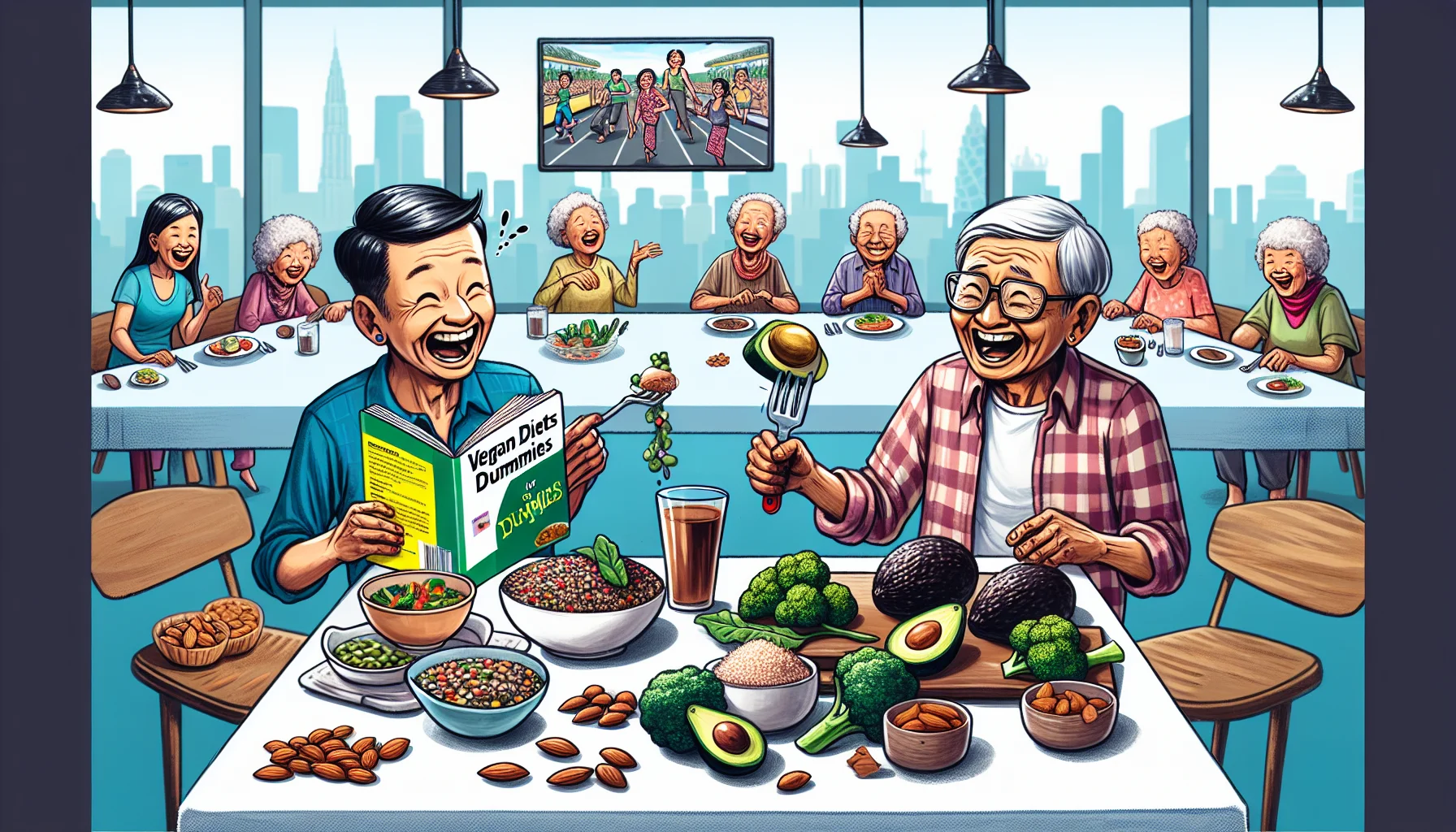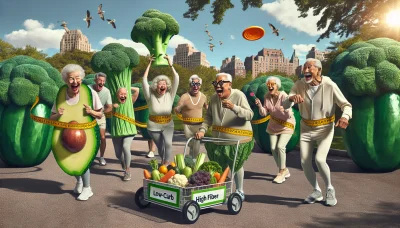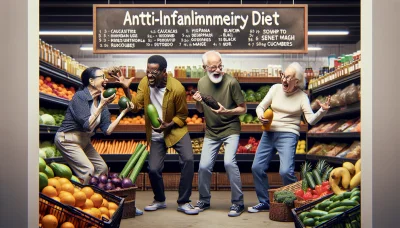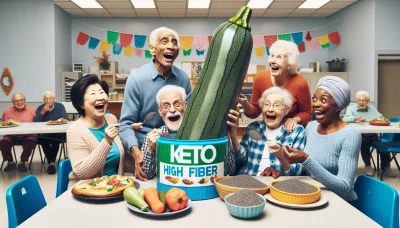Vegan foods high in fiber Quiz
Test Your Knowledge
Question of
Understanding Fiber in a Vegan Diet
The Role of Fiber in Nutrition
Fiber is a powerhouse for maintaining good health, especially in a vegan diet. It aids digestion, keeps you feeling full longer, and helps to prevent chronic diseases. Vegans often find it easier to meet their fiber needs due to the abundance of plant-based foods in their diets.
Digestive Health Benefits: A diet rich in fiber keeps the digestive system running smoothly, preventing constipation and supporting a healthy gut microbiome. The bulk provided by fiber also reduces the risk of developing diverticulitis and hemorrhoids.
Weight Management: High-fiber foods are more filling and take longer to eat. This can lead to lower calorie intake and help with maintaining or losing weight. Fiber's role in weight management is a vital aspect of overall health.
Blood Sugar Regulation: Fiber slows down the absorption of sugar into the bloodstream, which can prevent spikes in blood glucose levels. This is particularly beneficial for individuals managing diabetes or insulin resistance.
Types of Fiber and Their Sources
Fiber comes in two primary forms: soluble and insoluble. Both types play different roles in health and are found in varying amounts across food sources.
Soluble vs. Insoluble Fiber: Soluble fiber dissolves in water to form a gel-like substance that can lower cholesterol and stabilize blood sugar. Insoluble fiber adds bulk to stools, aiding in bowel movements.
Legumes, Grains, and Nuts: These are goldmines for fiber. Black beans, lentils, oats, almonds, and chia seeds are just a few examples that pack a high-fiber punch.
Fruits and Vegetables: Beyond their vitamin content, fruits like berries, apples, and pears; and vegetables such as broccoli, carrots, and Brussels sprouts are excellent sources of natural fiber.
- Tips for Incorporating More Fiber:
- Start your day with a high-fiber breakfast such as oatmeal or whole-grain toast.
- Add legumes like beans or lentils to soups, salads, or pasta dishes.
- Snack on fruits, nuts, or seeds instead of processed foods with little nutritional value.
- Increase your vegetable intake by including them in every meal; think stir-fries, stews, or even smoothies!
- Replace refined grains with whole-grain alternatives such as brown rice or quinoa.
- Stay hydrated to help fiber do its job effectively; water is key when upping fiber intake!
Daily Fiber Requirements
The recommended daily intake of fiber varies based on age and sex but generally falls between 25-38 grams per day for adults. Meeting these requirements is crucial for long-term health benefits.
Recommended Intake for Adults: Women should aim for at least 25 grams per day while men should target about 38 grams. These values can serve as a guideline for planning a balanced vegan diet.
Adjusting Fiber Intake for Individual Needs: Some people may need more or less fiber depending on their health status or life stage. Its important to listen to your body and adjust accordingly.
Signs of Inadequate Fiber Consumption: Symptoms such as irregular bowel movements, high cholesterol levels, and uncontrolled blood sugar could indicate low dietary fiber intake. Increasing consumption of plant-based foods can alleviate these issues.
Top High-Fiber Vegan Foods
Legumes: A Fiber Powerhouse
Legumes are the unsung heroes of a high-fiber vegan diet. Packed with not only fiber but also protein, they're an essential component for health and well-being. Including a variety of legumes in your meals can significantly boost your daily fiber intake.
Among the diverse world of legumes, each type brings its own unique texture and nutritional profile to the table. Regular consumption of these fiber-rich foods supports digestive health and can help maintain stable blood sugar levels.
Lentils and Their Versatility
Lentils are incredibly versatile and can be used in a range of dishes from hearty soups to refreshing salads. They cook relatively quickly and don't require pre-soaking, making them a convenient choice for those on the go. With their high fiber content, lentils are truly a nutritional powerhouse.
Black Beans in Vegan Recipes
Black beans are another stellar choice for adding fiber to your vegan diet. Their dense, meaty texture makes them ideal for creating satisfying dishes like black bean burgers or Mexican-inspired entrees. Black beans are not only filling but also rich in antioxidants.
Chickpeas as a Snack and Ingredient
Chickpeas have gained popularity as both a snack and key ingredient in vegan kitchens. Roasted chickpeas make an excellent high-fiber snack, while hummus provides a delicious way to add fiber to sandwiches and wraps. Chickpeas' versatility is unmatched!
Whole Grains for Sustained Energy
Whole grains are essential for long-lasting energy and provide a substantial amount of dietary fiber. Opting for whole grains over refined grains ensures you get the full spectrum of nutrients, including the bran and germ that are rich in fiber.
Quinoa and Its Nutritional Profile
Quinoa is not only high in fiber but also a complete protein, containing all nine essential amino acids. It's gluten-free, making it an excellent option for those with dietary restrictions. Quinoa's nutty flavor complements both sweet and savory dishes.
Oats for Breakfast Options
Oats are a breakfast staple in many vegan diets due to their high soluble fiber content, which can help lower cholesterol levels. They're incredibly versatile - enjoy them as porridge, overnight oats, or even blended into smoothies.
Brown Rice as a Staple Food
Brown rice is a whole grain that retains its natural fibers and nutrients. It's an excellent base for a variety of dishes from stir-fries to casseroles. Its mild flavor makes it easy to incorporate into any meal plan.
Nuts and Seeds with Added Benefits
- *Enumerative Lists: Used for itemizing elements, events, or tasks, often in a specific order. Ordered Lists: Sequence matters (e.g., procedural steps, rankings). Unordered Lists: Sequence does not matter (e.g., grocery lists, to-do lists). Descriptive Lists: Each item is accompanied by additional details or a description. Checklists: Designed for tracking completion or presence of items or tasks. Multilevel Lists: Nested lists with items having sub-items. Matrix Lists: Information presented in a two-dimensional grid or table format. Priority Lists: Items are organized based on their importance or urgency. Comparative Lists: Used for juxtaposing two or more items, options, or ideas. Here's why nuts and seeds are important: - They're rich in both soluble and insoluble fibers. - Many offer omega-3 fatty acids that benefit heart health. - They're packed with protein which helps keep you full longer. - The healthy fats found in nuts and seeds aid nutrient absorption.
Chia Seeds and Omega-3 Fatty Acids
Chia seeds are tiny but mighty when it comes to fiber content! These small seeds form a gel when mixed with liquids, creating interesting textures in foods like puddings while delivering essential omega-3 fatty acids alongside their impressive fiber content.
Almonds for Snacking and Meal Prep
Almonds are fantastic as both snacks and meal additions! They provide dietary fiber that aids digestion while also offering vitamin E and healthy fats. Whether eaten raw or added to dishes like salads, they contribute greatly to overall nutrition.
Flaxseeds in Baking and Smoothies
Incorporating flaxseeds into baking recipes or smoothies is an easy way to up your fiber intake. Ground flaxseeds can act as an egg substitute in vegan baking while providing both soluble and insoluble fibers critical for gut health.
Incorporating High-Fiber Foods into Meals
Breakfast Ideas to Start Your Day Right
Kickoff your morning with a nutrient-packed high-fiber smoothie! Blend leafy greens like spinach or kale with fiber-rich fruits such as berries and bananas. Add a scoop of chia seeds or flaxseeds for an extra fiber boost.
Vegan oatmeal variations are endless and exciting. Mix in nuts, seeds, and fresh fruit to rolled or steel-cut oats for a fulfilling breakfast. To enhance flavor and fiber content, stir in some almond butter or sprinkle on some coconut flakes.
Whole grain pancakes and waffles are not only delicious but also a fantastic way to incorporate more fiber into your breakfast. Swap out white flour for whole wheat or buckwheat flour and top with high-fiber fruits like apples or pears.
Lunch Options for Sustained Energy
For lunch, create hearty vegan salads that are anything but boring. Toss together mixed greens, chickpeas, sunflower seeds, and quinoa. Dress with a lemon-tahini dressing for a delightful crunch and lasting energy.
Whole grain wraps and sandwiches can carry you through the day without the slump. Fill them with a rainbow of vegetables, hummus, and beans for protein plus fiber that keeps you full longer.
- Soups Packed with Legumes and Vegetables: A bowl of soup can be a treasure trove of fiber. Lentils, black beans, and kidney beans combined with vegetables like carrots, tomatoes, and spinach create a hearty meal that's both comforting and nutritious.
- Mistakes to Avoid:
- Skipping on variety: Don't just stick to one type of vegetable or legume; variety ensures a range of nutrients.
- Oversimplifying meals: Adding herbs, spices, or a splash of citrus can turn a bland dish into something mouth-watering without sacrificing health benefits.
- Overcooking vegetables: To preserve their nutritional value and fiber content, cook vegetables until they're just tender.
- Ignoring whole grains: Opt for whole grain breads or wraps instead of refined versions to maximize your fiber intake at lunchtime.
Dinner Dishes Rich in Fiber
Stir-fries offer an excellent opportunity to combine high-fiber veggies like broccoli, bell peppers, and snap peas with tofu or tempeh for a satisfying evening meal. Use brown rice or quinoa as your base for an added fiber punch!
A bowl of vegan chili is perfect for those cooler nights. Mix various beans such as black beans, pinto beans, and lentils with tomatoes, corn, and peppers for a comforting dish brimming with fiber.
Incorporate whole wheat pasta into your dinner rotation by pairing it with vegetable-rich sauces like marinara loaded with mushrooms, zucchini, and eggplant. It's a tasty way to ensure you're getting enough fiber while indulging in pasta night!
Balancing a High-Fiber Vegan Diet
Combining Macronutrients for Optimal Health
When embracing a high-fiber vegan diet, it's crucial to nail the balance of macronutrients. This means ensuring you're getting enough protein, fats, and carbohydrates. A well-planned diet prevents nutrient deficiencies and supports overall health, allowing vegans to thrive!
Protein Sources in a Vegan Diet : Vegans can obtain ample protein from legumes, nuts, seeds, and whole grains. Incorporating a variety of these sources is key to covering all essential amino acids. Tofu, lentils, and quinoa are powerhouse options that should be staples in any vegan pantry.
Healthy Fats to Include : Don't skimp on fats! Avocados, chia seeds, and walnuts provide omega-3 fatty acids vital for brain health. Including a mix of saturated and unsaturated fats helps in absorbing fat-soluble vitamins A, D, E, and K.
Complex Carbs for Energy Balance : Complex carbohydrates like sweet potatoes, brown rice, and oats release energy slowly. They keep blood sugar levels stable while providing the body with sustained fuel. Plus, they're loaded with fiber which is essential for digestive health.
Avoiding Common Dietary Deficiencies
Vegans need to be vigilant about certain nutrients that are commonly deficient in plant-based diets. Understanding what these are and how to get them will safeguard your health.
Importance of Vitamin B12 and Iron : Vitamin B12 is predominantly found in animal products. Therefore, vegans should look to fortified foods or supplements to meet their needs. Iron is plentiful in plant foods like spinach and beans; however, it's not as easily absorbed as the iron from meat. Consuming vitamin C-rich foods alongside can enhance absorption.
Ensuring Adequate Calcium Intake : Calcium is crucial for bone health. Fortified plant milks, tofu set with calcium sulfate, and leafy greens are excellent vegan sources of calcium.
Monitoring Vitamin D Levels in Vegans : With limited sun exposure or dietary intake, vitamin D levels can fall short. Supplements may be necessary to maintain optimal levels for bone health and immune function.
- *
- Regularly include fortified foods like cereals and plant milks in your diet. *
- Eat vitamin C-rich fruits and vegetables alongside iron-containing plants to boost absorption. *
- Schedule routine blood checks to monitor vitamin B12, iron, calcium, and vitamin D levels. *
- Explore vegan supplements if your dietary intake falls short or if you have increased nutritional needs. *
- Maintain a diverse diet full of colorful fruits and vegetables to cover a wide range of nutrients.
Hydration and Fiber Intake
A high-fiber diet works wonders for the digestive system but requires adequate hydration to prevent issues such as constipation or bloating. Proper fluid intake ensures that fiber moves smoothly through the digestive tract.
The Importance of Water with High-Fiber Diets : As fiber absorbs water in the gut, not drinking enough can lead to discomfort. It's essential to drink plenty of fluids throughout the dayaim for at least 8 glasses or more depending on activity levels.
Signs of Dehydration to Watch For : Dry mouth, fatigue, dark urinethese are all warning signs that you're not drinking enough fluids. Pay attention to your body's signals; thirst often indicates that you're already dehydrated!
Best Practices for Fluid Intake : Don't wait until you're thirsty! Sip water consistently throughout the day. Flavoring water with fruits or herbs can make it more appealing if plain water doesn't excite you. Remember that fruits and veggies also contribute to your daily water intake!
Digestive Health on a Vegan Diet
Managing Digestive Comfort with Fiber Intake
Easing into Increased Fiber Consumption is crucial when adopting a vegan diet. A sudden surge in fiber can lead to discomfort, so it's vital to increase intake gradually. Start with small portions of high-fiber foods and progressively add more to allow your digestive system to adapt.
Dealing with Gas and Bloating can be a common issue as your body adjusts to more fiber. To mitigate these effects, focus on well-cooked legumes, chew thoroughly, and stay hydrated. Over time, your digestive system will become more efficient at processing fiber-rich foods.
The Importance of Gut Microbiota Diversity cannot be overstated. A varied vegan diet rich in different types of plant fibers can promote a healthy gut microbiome, which is essential for overall digestive health and can enhance nutrient absorption.
Prebiotics and Probiotics in Vegan Foods
The role of Sources of Prebiotics in Plant-Based Diets is to feed the beneficial bacteria in your gut. Foods such as garlic, onions, asparagus, and bananas are excellent vegan sources of prebiotics that support a healthy digestive ecosystem.
Fermented Foods as Probiotic Sources offer live cultures that can benefit gut health. Including items like sauerkraut, kimchi, miso, and tempeh in your vegan diet introduces probiotics naturally without the need for supplements.
To effectively integrate these beneficial elements into your diet, consider the synergy between Integrating Prebiotics and Probiotics Naturally . Consuming them together can enhance their positive effects on the digestive system.
Tips for Smooth Digestive Transition to Veganism
- Gradual Changes to Avoid Discomfort: Instead of an abrupt switch, slowly replace non-vegan items with plant-based alternatives over several weeks or months.
- Food Pairing for Better Digestion: Combine foods rich in vitamin C with iron-rich plant foods to improve iron absorption. Eating whole grains with legumes can also create complete proteins.
- Recognizing Personal Food Sensitivities: Pay attention to how your body reacts to new foods and adjust accordingly. If certain items cause issues, try eliminating them temporarily to see if symptoms improve.
Special Considerations for High-Fiber Vegan Diets
Athletes' Nutritional Needs on a Vegan Diet
Athletes following a vegan diet must focus on meeting their increased energy needs. High-fiber foods can be excellent energy sources but require careful planning to ensure adequate caloric intake. It's crucial to select fiber-rich foods that are also high in calories, such as nuts, seeds, and avocados, to fuel rigorous training.
Recovery is as important as the workout itself for vegan athletes. To maximize recovery, incorporating fiber-rich foods that are also protein-dense is key. Think beans, lentils, and quinoathese powerhouses aid in muscle repair and recovery while contributing to your daily fiber goals.
Balancing meals for endurance and strength requires a strategic approach on a vegan diet. Athletes should aim for a variety of carbohydrates, proteins, and fats at each meal, ensuring energy levels remain consistent. Complex carbohydrates with high fiber content like whole grains provide sustained energy release.
Weight Management with a High-Fiber Diet
The satiety factor of high-fiber foods is a game-changer for weight management. Fiber adds bulk without extra calories, helping you feel full longer. This natural appetite suppressant found in fruits, vegetables, and legumes can reduce overall calorie intake without compromising nutrition.
When it comes to weight loss, the caloric density of food matters greatly. A high-fiber vegan diet often comprises low-caloric density foods which means you can eat larger volumes without consuming too many caloriesa win for those looking to shed pounds while still eating plentifully.
Strategic snacking plays a pivotal role in hunger control throughout the day. Opting for snacks that are rich in fiber can help maintain blood sugar levels and prevent overeating during meals. Here's a list of top high-fiber snacks to include:
- Fresh fruit like apples or pears with skin
- Raw vegetables like carrots or bell peppers with hummus
- Air-popped popcorn seasoned with nutritional yeast
- Nuts and seeds mixed with dried fruits
- Whole-grain toast with almond butter and banana slices
Planning a Balanced Vegan Diet for All Ages
Children on vegan diets have specific nutritional requirements to support their growth and development. High-fiber foods should be introduced gradually while ensuring they are getting sufficient calories from varied sources such as fortified plant milks, whole grains, nuts, and seeds.
During pregnancy, maintaining a balanced vegan diet is crucial for both mother and child's health. Pregnant women should focus on fiber-rich foods that are also dense in nutrients like iron, calcium, and folatethink leafy greens, legumes, nuts, and seedsall vital during this critical time.
Seniors may have different digestive systems that require special attention to fiber intake. An adequate amount of fiber can support digestion and prevent constipationa common issue among older adults. However, it's essential not to overlook other nutrients such as B12 and calcium which can be less abundant in vegan diets but crucial for seniors' health.












